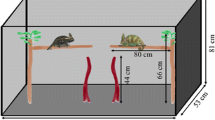Abstract
Agonistic contests between lobsters housed together in a confined space progress through encounters of increasing intensity until a dominance relationship is established. Once this relationship is established, losing animals continually retreat from the advances of winners.
These encounters are likely to consume much energy in both winning and losing animals. Therefore, one might expect involvement of many physiological systems before, during and after fights. Here, we report effects of agonistic encounters on cardiac frequency in winning and losing adult lobsters involved in dyadic interactions.
The results show that: (i) small but significant increases in heart rate are observed upon chemical detection of a conspecific; (ii) during agonistic interactions, further increases in heart rate are seen; and (iii) ultimate winners exhibit greater increases in heart rate lasting longer periods of time compared to ultimate losers. Heart rate in winners remains elevated for at least 15 min after the contests have ended and animals have been returned to their home tanks. Reduced effects are seen in second and third pairings between familiar opponents.
The sustained changes in heart rate that we observe in winning lobsters may result from hormonal modulation of cardiac function related to the change in social status brought about by contest outcome.
Similar content being viewed by others
References
Atema, J., and Voigt, R. (1995). Behavior and sensory biology. In Factor, J. F. (ed.), The Biology of the Lobster, Academic Press, New York, pp. 313–348.
Breithaupt, T., Lindstrom, D. P., and Atema, J. (1999). Urine release in freely moving catheterized lobsters (Homarus americanus) with reference to feeding and social behavior. J. Exp. Biol. 202:837–844.
Breithaupt, T., and Atema, J. (2000). The timing of chemical signal with urine in dominance fights of male lobsters (Homarus americanus). Behav. Ecol. Sociobiol. 49:67–78.
Cooke, I. M. (1988). Studies on the crustacean cardiac ganglion. Comp. Biochem. Physiol. 91(C):205–218.
Cooke, I. M., and Sullivan, J. E. (1982). Hormones and neurosecretion. In Atwood, H., and Sandeman, D. (eds.), The Biology of Crustacea, Vol. 4, Academic Press, New York, pp. 205–290.
De Wachter, B., and McMahon, B. R. (1996). Temperature effects on heart performance and regional hemolymph flow in the crab Cancer magister. Comp. Biochem. Physiol. 114(A):27–33.
Dufort, C. G., Jury, S. H., Newcomb, J. M., O’Grady, D. F. III, and Watson, W. H. III (2001). Detection of salinity by the lobster, Homarus americanus. Biol. Bull. 201:424–434.
Field, L. H., and Larimer, J. L. (1975a). The cardioregulatory system of crayfish: Neuroanatomy and physiology. J. Exp. Biol. 62:519–530.
Field, L. H., and Larimer, J. L. (1975b). The cardioregulatory system of crayfish: The role of the circumesophageal neurons. J. Exp. Biol. 62:531–543.
Florey, E., and Kriebel, M. E. (1974). The effects of temperature, anoxia and sensory stimulation on the heart rate of unrestrained crabs. Comp. Biochem. Physiol. 48(A):285–300.
Huber, R., and Kravitz, E. A. (1995). A quantitative analysis of agonistic behavior in juvenile American lobsters (Homarus americanus). Brain Behav. Evol. 46:72–83.
Jacobson, S. (1977). Shelter Use and Dominance Behavior in American Lobsters, Homarus americanus, in Seminatural Habitats, Thesis, Boston University Marine Program, Boston, Massachusetts.
Jury, S. H., and Watson, W. H. III (2000). Thermosensitivity of the lobster, Homarus americanus, as determined by cardiac assay. Biol. Bull. 199:257–264.
Karavanich, K., and Atema, J. (1998a). Individual recognition and memory in lobster dominance. Anim. Behav. 56:553–1560.
Karavanich, K., and Atema, J. (1998b). Olfactory recognition of urine signals in dominant fights between male lobster, Homarus americanus. Behaviour 153:718–730.
Larimer, J. L. (1964). Sensory-induced modifications of ventilation and heart rate in crayfish. Comp. Biochem. Physiol. 12:25–36.
Listerman, L. R., Deskins, J., Bradacs, H., and Cooper, R. L. (2000). Heart rate within male crayfish: Social interactions and effects of 5-HT. Comp. Biochem. Physiol. 125(A):251–263.
Maynard, D. M. (1960). Circulation and heart function. In Waterman, T. H. (ed.), The Physiology of Crustacea, Academic Press, New York, pp. 161–214.
McMahon, B. R. (1999). Intrinsic and extrinsic influences on cardiac rhythms in crustaceans. Comp. Biochem. Physiol. A 124:539–547.
McMahon, B. R., and Wilkens, J. L. (1975). Respiratory and circulatory responses to hypoxia in the lobster Homarus americanus. J. Exp. Biol. 62:637–655.
Mello, J. J., Cromarty, S. I., and Kass-Simon, G. (1999). Increased aggressiveness in gravid American lobsters, Homarus americanus. Aggressive Behav. 25:451–472.
Offut, G. C. (1970). Acoustic stimulus perception by the American lobster Homarus americanus (Decapoda). Experientia 26:1276–1278.
Rose, R. A., Wilkens, J. L., and Walker, R. L. (1998). The effects of walking on heart rate, ventilation and acid-base status in the lobster Homarus americanus. J. Exp. Biol. 201:2601–2608.
Rutishauser, R. L., Cromarty, S. I., Basu, A. C., and Kravitz, E. A. (2004). Long-term consequences of agonistic interactions between socially naïve juvenile American lobsters (Homarus americanus). Biol. Bull. 207:183–187.
Schapker, H., Breithaupt, T., Shuranova, Z., Burmistrov, Y., and Cooper, R. L. (2002). Heart and ventilatory measures in crayfish during environmental disturbances and social interactions. Comp. Biochem. Physiol. 131(A):397–407.
Scrivener, J. C. E. (1971). Agonistic behavior in the American lobster Homarus americanus. Fish. Res. Board Can. Tech. Rep. 235:1–113.
Tamm, G. R., and Cobb, J. S. (1978). Behavior and the crustacean molt cycle: Changes in aggression of Homarus americanus. Science 200:79–81.
Wilkens, J. L., and McMahon, B. R. (1992). Intrinsic properties and extrinsic neurohormonal control of crab hemodynamics. Experientia 48:827–834.
Yeh, S.-H., Fricke, R. A., and Edwards, D. H. (1996). The effect of social experience on serotonergic modulation of the escape circuit of crayfish. Science 271:366–369.
Yeh, S.-H., Musolf, B. E., and Edwards, D. H. (1997). Neuronal adaptations to changes in the dominance status of crayfish. J. Neurosci. 17:697–708.
Author information
Authors and Affiliations
Corresponding author
Rights and permissions
About this article
Cite this article
Hernández-Falcón, J., Basu, A.C., Govindasamy, S. et al. Changes in Heart Rate Associated with Contest Outcome in Agonistic Encounters in Lobsters. Cell Mol Neurobiol 25, 329–343 (2005). https://doi.org/10.1007/s10571-005-3063-x
Received:
Accepted:
Issue Date:
DOI: https://doi.org/10.1007/s10571-005-3063-x




